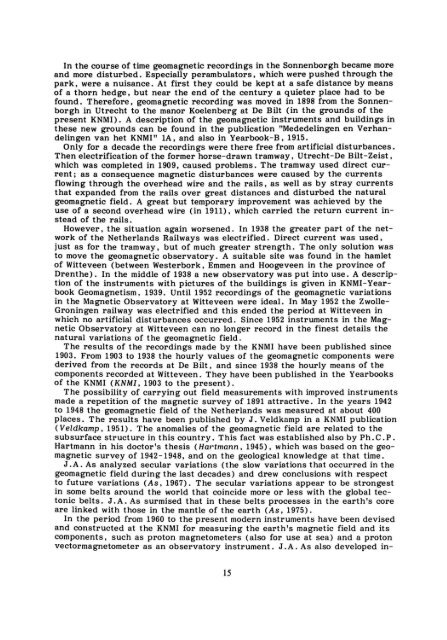History of Geophysical Research in The Netherlands ... - DWC - KNAW
History of Geophysical Research in The Netherlands ... - DWC - KNAW
History of Geophysical Research in The Netherlands ... - DWC - KNAW
Create successful ePaper yourself
Turn your PDF publications into a flip-book with our unique Google optimized e-Paper software.
In the course <strong>of</strong> time geomagnetic record<strong>in</strong>gs <strong>in</strong> the Sonnenborgh became more<br />
and more disturbed. Especially perambulators, which were pushed through the<br />
park, were a nuisance. At first they could be kept at a safe distance by means<br />
<strong>of</strong> a thorn hedge, but near the end <strong>of</strong> the century a quieter place had to be<br />
found. <strong>The</strong>refore, geomagnetic record<strong>in</strong>g was moved <strong>in</strong> 1898 from the Sonnenborgh<br />
<strong>in</strong> Utrecht to the manor Koelenberg at De Bilt (<strong>in</strong> the grounds <strong>of</strong> the<br />
present KNMI). A description <strong>of</strong> the geomagnetic <strong>in</strong>struments and build<strong>in</strong>gs <strong>in</strong><br />
these new grounds can be found <strong>in</strong> the publication "Mededel<strong>in</strong>gen en Verhandel<strong>in</strong>gen<br />
van het KNMI" lA, and also <strong>in</strong> Yearbook-B, 1915.<br />
Only for a decade the record<strong>in</strong>gs were there free from artificial disturbances .<br />
<strong>The</strong>n electrification <strong>of</strong> the former horse-drawn tramway, Utrecht-De Bilt-Zeist,<br />
which was completed <strong>in</strong> 1909, caused problems. <strong>The</strong> tramway used direct current;<br />
as a consequence magnetic disturbances were caused by the currents<br />
flow<strong>in</strong>g through the overhead wire and the rails, as weIl as by stray currents<br />
that expanded from the rails over great distances and disturbed the natural<br />
geomagnetic field. A great but temporary improvement was achieved by the<br />
use <strong>of</strong> a second overhead wire (<strong>in</strong> 1911), which carried the return current <strong>in</strong>stead<br />
<strong>of</strong> the rails.<br />
However, the situation aga<strong>in</strong> worsened. In 1938 the greater part <strong>of</strong> the network<br />
<strong>of</strong> the <strong>Netherlands</strong> Railways was electrified. Direct current was used,<br />
just as for the tramway, but <strong>of</strong> much greater strength . <strong>The</strong> only solution was<br />
to move the geomagnetic observatory. A suitable site was found <strong>in</strong> the hamiet<br />
<strong>of</strong> Witteveen (between Westerbork, Emmen and Hoogeveen <strong>in</strong> the prov<strong>in</strong>ce <strong>of</strong><br />
Drenthe). In the middle <strong>of</strong> 1938 a new observatory was put <strong>in</strong>to use. A description<br />
<strong>of</strong> the <strong>in</strong>struments with pictures <strong>of</strong> the build<strong>in</strong>gs is given <strong>in</strong> KNMI-Yearbook<br />
Geomagnetism, 1939. Until 1952 record<strong>in</strong>gs <strong>of</strong> the geomagnetic variations<br />
<strong>in</strong> the Magnetic Observatory at Witteveen were ideal. In May 1952 the Zwolle<br />
Gron<strong>in</strong>gen railway was electrified and this ended the period at Witteveen <strong>in</strong><br />
which no artificial disturbances occurred. S<strong>in</strong>ce 1952 <strong>in</strong>struments <strong>in</strong> the Magnetic<br />
Observatory at Witteveen can no longer record <strong>in</strong> the f<strong>in</strong>est details the<br />
natural variations <strong>of</strong> the geomagnetic field.<br />
<strong>The</strong> results <strong>of</strong> the record<strong>in</strong>gs made by the KNMI have been published s<strong>in</strong>ce<br />
1903. From 1903 to 1938 the hourly values <strong>of</strong> the geomagnetic components were<br />
derived from the records at De Bilt, and s<strong>in</strong>ce 1938 the hourly means <strong>of</strong> the<br />
components recorded at Witteveen . <strong>The</strong>y have been published <strong>in</strong> the Yearbooks<br />
<strong>of</strong> the KNMI (KNMI, 1903 to the present).<br />
<strong>The</strong> possibility <strong>of</strong> carry<strong>in</strong>g out field measurements with improved <strong>in</strong>struments<br />
made a repetition <strong>of</strong> the magnetic survey <strong>of</strong> 1891 attractive. In the years 1942<br />
to 1948 the geomagnetic field <strong>of</strong> the <strong>Netherlands</strong> was measured at about 400<br />
places. <strong>The</strong> results have been published by J. Veldkamp <strong>in</strong> a KNMI publication<br />
(Veldkamp , 1951). <strong>The</strong> anomalies <strong>of</strong> the geomagnetic field are related to the<br />
subsurface structure <strong>in</strong> this country. This fact was established also by Ph.e.p.<br />
Hartmann <strong>in</strong> his doctor's thesis (Hm'tmann. 1945), which was based on the geomagnetic<br />
survey <strong>of</strong> 1942-1948, and on the geological knowledge at that time.<br />
J.A. As analyzed secular variations (the slow variations that occurred <strong>in</strong> the<br />
geomagnetic field dur<strong>in</strong>g the last decades) and drew conciusions with respect<br />
to future variations (As, 1967). <strong>The</strong> secular variations appear to be strongest<br />
<strong>in</strong> some beits around the world that co<strong>in</strong>cide more or less with the global tectonic<br />
belts. J. A. As surmised that <strong>in</strong> these belts processes <strong>in</strong> the earth 's core<br />
are l<strong>in</strong>ked with those <strong>in</strong> the mantIe <strong>of</strong> the earth (As, 1975).<br />
In the period from 1960 to the present modern <strong>in</strong>struments have been devised<br />
and constructed at the KNMI for measur<strong>in</strong>g the earth 's magnetic field and its<br />
components, such as proton magnetometers (also for use at sea) and a proton<br />
vectormagnetometer as an observatory <strong>in</strong>strument. J.A. As also developed <strong>in</strong>-<br />
15

















